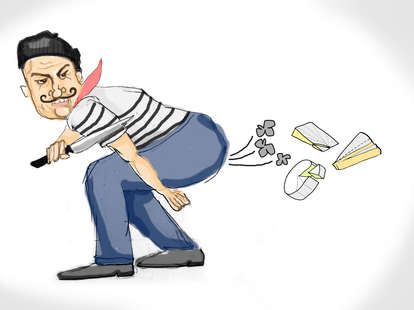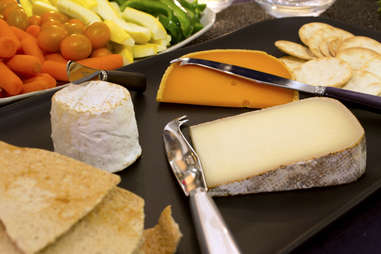How to cut the cheese like a Frenchman (literally)

The French love beautiful things almost as much as they think all Americans love kale. And of course, they love their cheese. It only makes sense, then, that they put a great deal of thought into how they cut the cheese -- and we're not talking about crop-dusting coworkers.
Cheese slicing is actually a much more particular process than you'd imagine, so we had a real-life French dude explain the rules and regulations regarding one of the most sacred foodstuffs in traditional French cuisine: the cheese course.
The reasoning behind the process is two-fold; it ensures that everyone getting in on the plate o’ fromage gets an even piece, both in size and amount of rind, and that the picked-at platter remains as handsome as it was before all the carving and serving.

Step 1: Cut with the correct knife
One knife per individual cheese! You can’t have that Brie creaming all over the Comte and mingling flavors. Each hunk of delectable dairy goodness must be coddled, and not all knives are created equal.
Slicers and other fromage flatware come in a myriad of styles and sizes, each intended for a specific texture of cheese, and some come with a forked tip, which can be used to move the cheese once it has been properly cut. It's not just for decoration.
And take note: Do NOT saw the good stuff, but cut in one fluid motion. Rock the knife back and forth if the cheese won’t budge under the blade. Also, no pre-cutting before curd-eaters arrive — cut the cheese right before serving. Probably the first time anyone has ever told you to cut the cheese in front of a crowd...
Cut medium-hard to medium-soft cheeses with a wire slicer
The thin stretched wire and sturdy handle will carve thick, even cuts through cheeses like Emmental, Raclette, and Morbier with ease.
Cut crumbly cheeses with wide, rectangular, open-surface blades
Knives with holes are preferable for Roquefort and other blue cheeses. The smaller surface area prevents the blue veins from sticking to the knife, which maintains the structural integrity of the slice. This is paramount.
Cut soft-ripened cheese with a hollow-edge blade
The evenly spaced vertical indentations on this kind of blade will keep creamy Brie, Camembert, or Mont d’Or from sticking.
Cut hard cheeses with a tear-shaped knife
Slide the tip in first (yup) and push down with force. Harder cheeses like Gruyere, Cantal, or Beaufort will sometimes crumble into larger chunks under the pressure. You may crumble, too, from the stress of knowing which blades match which cheeses.

Step 2: Keep the rind in place
Some cheeses come entirely encased in a rind, like Brie or a big ol' wheel of goat cheese. Your guests, being cultured turophiles (that's a cheese connoisseur, if you're the uninitiated), will like to see how ripe the whey inside that rind is, and you will show them by cutting the “l’entame”, which is the first slice.
And no digging out the gooey middle of the Brie, you American barbarian. It’s customary to eat the rind of soft and blue cheeses. All of it. However, our Frenchman notes that you can feel free to remove the rind of the harder cheeses before eating. No need to always rind it out.

Step 3: Determine the form of the fromage
With cutlery chosen and rinds in line, the next thing to consider is the shape of your cheese.

Intersect the middle in even-wedged, triangular slices. Same goes for atypical shapes, like the heart-shaped Neufchatel.

It's pretty straightforward.




Step 4: Place gingerly on morsel of bread, devour
Now that you have successfully cut the cheese, it is important to distribute your slice on the flavor vehicle of choice. You can do better than just a Triscuit. Invest in some good French bread. Enjoy it straight up, on a roll. Spreading the cheese, however, is a big faux pas.
As French epicure and gastronome Jean-Anthelme Brillat-Savarin said, “A dessert without cheese is a beauty who misses an eye”. And as we say, “Cheese cut incorrectly is still delicious".
Suck it, France.
Carrie Dennis is a writer for Thrillist Media Group and won't hesitate to break all the rules when it comes to eating Camembert. Follow her to all kinds of other cheese on Twitter @CarrrieDennnis.